Physical Address
304 North Cardinal St.
Dorchester Center, MA 02124
On completion of this chapter, you should be able to:
Describe the anatomy encountered during a venous duplex imaging examination
Understand venous physiology as it relates to the development of peripheral venous disease
List the risk factors, signs, and symptoms of venous disease
Outline the proper instrument control settings used during venous duplex imaging
Describe the characteristics of venous Doppler signals obtained during venous duplex imaging
Describe the imaging characteristics of a normal venous system
Discuss the imaging characteristics associated with deep vein thrombosis and venous reflux
Peripheral venous disease may be categorized as an acute or a chronic process and can present in the upper and lower extremities. Ultrasound technology enables dynamic, nonionizing, and portable imaging to be acquired in real time, making it an ideal radiologic modality for the interrogation of venous pathology. Among these advantages is its ability to perform color Doppler (CD) and spectral Doppler (SD) imaging, providing the capability to evaluate both the anatomy and physiologic processes of the venous system. To this end, ultrasound imaging is tasked with conducting a variety of venous imaging examinations, spanning multiple areas of the body.
Venous pathology can take many forms; however, deep vein thrombosis (DVT) has a high prevalence and is arguably the most medically concerning. Characterized by a thrombus, or blood clot, in a deep vein(s), DVT can occur peripherally in the upper and lower extremities, although more commonly within the deep veins of the legs. Although the exact incidence or prevalence of DVT in the United States is unknown due to many going undetected, 857,000 cases are estimated to occur annually. The concerning nature of this disease arises from a complication that can occur when a thrombus dislodges from the venous lumen and propagates to the arteries of the lungs. This is known as a pulmonary embolism (PE) or venous thromboembolism (VTE) when describing both the DVT and PE. VTE is the third most common cardiovascular disorder in the United States behind myocardial infarction and stroke, with approximate lifetime risk of 1 in 12 adults in the United States, and maintains a fairly high mortality rate. Thus a timely and accurate diagnosis of DVT is imperative.
The signs and symptoms of DVT are common and nonspecific, meaning they may have several other possible causes (e.g., musculoskeletal disorders, ruptured Baker cyst, cellulitis), making a DVT diagnosis based on solely on signs and symptoms unreliable. This, coupled with the criticality of an accurate DVT diagnosis, has caused the peripheral venous duplex examination to become one of the most commonly ordered vascular sonograms.
Besides a PE, other less severe complications of DVT can often result. Postthrombotic syndrome (PTS) consists of chronic leg pain, inflammation, redness, and ulcers. Deep and superficial venous insufficiency, varicose veins, and recurrent DVT are also common manifestations of PTS. Ultrasound imaging is also often used for the evaluation of these DVT complications. Therefore it is necessary to understand and recognize the presentation of a wide variety of venous diseases because the versatility and advantages of ultrasound imaging make it the radiologic modality that is most often initially used for venous pathology detection and evaluation.
The peripheral venous portion of the circulatory system is located in the upper and lower extremities and consists of the deep, superficial, and perforating (communicating) veins. The main function of the peripheral venous system is to return deoxygenated blood from organs and body tissues back to the heart. In the periphery, deoxygenated blood leaving the capillaries enters the venules of venous microcirculation. From the venules, venous blood drains into the superficial veins and from there to the deep veins. Perforating veins provide a channel between superficial and deep veins.
Like arteries, veins are made up of three layers: (1) tunica intima (innermost), (2) tunica media (middle), and (3) tunica adventitia (outermost). However, these layers differ from those of the arteries in that the venous tunica media layer is poorly developed. The tunica media is the muscular layer of the lumen, and it provides the vessel with stability. As a result, veins are more elastic and less rigid than arteries.
The presence of venous valves is another unique feature of the venous system. Venous valves are bicuspid and unidirectional folds that arise from the tunica intima. These valves serve to maintain antegrade venous blood flow (from the peripheral to central veins, toward the heart). These one-way valves are necessary due to the effects placed upon blood flow within the peripheral veins from hydrostatic pressure. Hydrostatic pressure, also known as gravitational pressure when standing upright, is defined as the pressure placed on a fluid in a column as a result of gravity. Because the heart is located above many of the peripheral veins, the blood traveling upward in the peripheral venous system must flow against the pressure placed on it from the weight of the column of blood that exists above it. Accordingly, the further a point within a peripheral vein is from the heart, the more opposing hydrostatic pressure the blood in it must overcome. For this reason, venous valves increase in quantity in the distal portions of the lower extremities.
As the name suggests, lower extremity deep veins are located deep within the muscles of the legs and serve as the primary route of drainage for the leg ( Fig. 40.1 ). Consequently, deep veins are typically larger than superficial veins because they must support a larger blood volume. Lower extremity deep veins also have corresponding arteries located in close proximity to them.
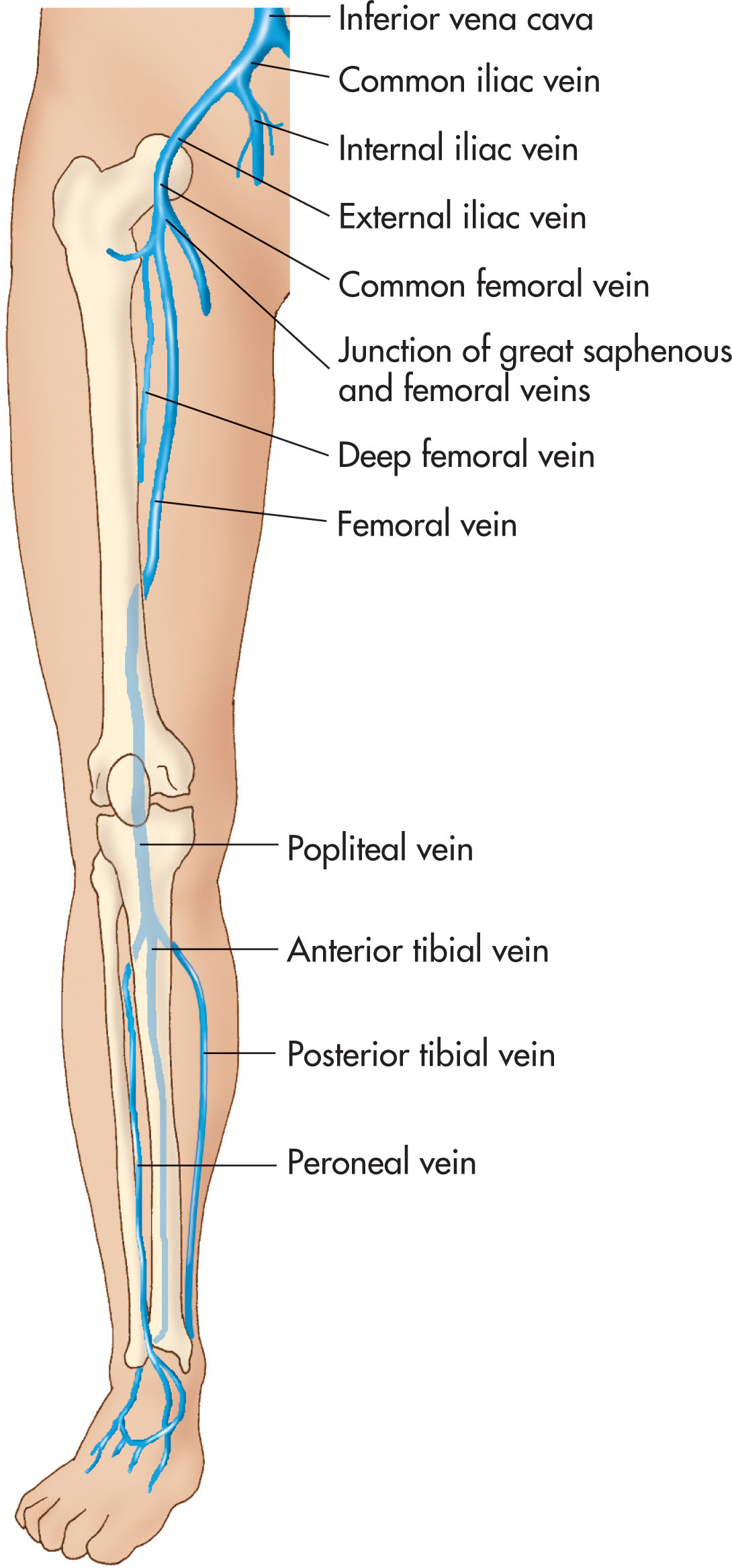
Beginning distally, the anterior tibial veins (ATVs) are a set of paired veins that drain blood from the dorsum of the foot (dorsalis pedis veins) and the anterior compartment of the calf. Originating near the tibia at the level of the ankle, the ATVs are located anterior to the interosseous membrane, as they ascend the lower leg with the anterior tibial artery. Ultimately the ATVs join the posterior tibial veins (PTVs) to form the popliteal vein.
The posterior tibial veins (PTVs) are a set of paired veins that drain the posterior compartment of the lower leg and originate from the plantar veins (superficial and deep) of the foot. The PTVs ascend along the medial calf beginning at the level of the medial malleolus, parallel to the posterior tibial artery. In the proximal calf, the PTVs combine with the peroneal veins to form the tibial-peroneal trunk, just before uniting with ATVs to form the popliteal vein.
The peroneal veins (also known as the fibular veins) are another set of paired veins that drain blood from the lateral compartment of the lower leg. The peroneal veins parallel the path of the PTVs, located deep to the soleus and gastrocnemius muscles along the fibula. Also traveling with the peroneal veins is the peroneal artery (also known as the fibular artery). In the proximal calf, the peroneal veins join the PTVs to form the tibial-peroneal trunk.
The final deep veins of the lower leg are the soleal sinuses and the gastrocnemius (sural) veins . These veins are located deep within the muscular compartments of the soleus and gastrocnemius muscles, respectively. The soleal sinuses are large reservoirs of venous blood that drain to the PTVs or peroneal veins. The gastrocnemius veins are a set of paired veins that, accompanied by the gastrocnemius artery, ascends the leg in the medial and lateral gastrocnemius muscles before draining directly into the popliteal vein.
The popliteal vein drains the blood of the lower leg and originates from the confluence of the ATVs with the peroneal and PTVs (tibial-peroneal trunk). The popliteal vein is located in the popliteal fossa (area behind the knee), in close proximity to the popliteal artery. In the lower popliteal fossa, the popliteal vein is medial and superficial to the artery. As they ascend the popliteal space, the popliteal vein remains superficial but moves lateral to the artery. The popliteal vein and artery continue to ascend until they pass through the adductor canal (Hunter canal) at the approximate level of the knee joint. Here they become the femoral vein (FV) and artery. A duplicated popliteal vein has been reported in up to 40% of the population.
The femoral vein (FV) originates from the popliteal vein in the distal thigh at the hiatus of the adductor magnus muscle, at the level of the adductor (Hunter) canal. The FV is accompanied by the femoral artery, to which it courses deep throughout the medial thigh. The FV terminates in Scarpa’s (femoral) triangle at its confluence with the deep profunda femoris (deep femoral) vein. A duplicated FV is present in up to an estimated 41% of the population. Recognition and thorough evaluation of a duplicated FV system is imperative because 20% of all lower extremity DVTs are isolated to the FV. Furthermore, one study reported duplicated or triplicated popliteal and FVs were not documented on repeat evaluation. It is important to note that the FV is often referred to as the superficial FV . This nomenclature began as a method of differentiating the FV from the profunda femoris (also referred to as the deep FV). However, adding superficial to the name brought about confusion among clinicians. This resulted in DVTs located in the FV being left untreated because they were mistakenly thought to be within the superficial system. In 2004 an international interdisciplinary committee of physicians met to discuss issues regarding terminology of the lower limb veins. The committee concluded that the word superficial be omitted and only the term femoral vein be used. Furthermore, accreditation organizations, including the Intersocietal Accreditation Commission (IAC) strongly recommend omitting superficial when referring to the FV. Similarly, the same revised nomenclature is applied to the femoral artery.
The profunda femoris vein , also known as the deep FV, drains the deep muscles of the proximal thigh. Similar to other deep veins of the leg, the profunda femoris travels in proximity to the profunda femoris artery. The profunda femoris vein ascends the upper leg until it joins the FV to form the common FV. The confluence of these two veins is distal to the bifurcation of the common femoral artery.
The common femoral vein (CFV) is formed by the confluence of the FV and profunda femoris vein. The CFV also receives the great saphenous vein (GSV) at the level of the saphenofemoral junction. The CFV lies in the Scarpa triangle, medial to the common femoral artery. The CFV terminates at the level of the inguinal ligament, where it becomes the external iliac vein.
The external iliac vein originates at the level of the inguinal ligament as a continuation of the CFV. The external iliac ascends parallel to the external iliac artery before it joins the internal iliac vein to become the common iliac vein. The internal iliac vein travels with the internal iliac artery and serves to drain the pelvis before it joins the external iliac vein.
The common iliac vein is formed by the confluence of internal and external iliac veins. Further proximal, the union of the right and left common iliac veins forms the inferior vena cava (IVC). The left common iliac vein is oriented obliquely and lies medial to the left common iliac artery. While they ascend, the left common iliac vein must cross beneath the right iliac artery to join the right common iliac vein at their confluence to form the IVC. This anatomic feature of the left common iliac vein crossing beneath the right iliac artery causes mild compression of the vein and has been cited as the reason for slightly greater prevalence of left-side DVT. Continued compression can result in the venous entrapment disorder known as May-Thurner syndrome, which is characterized by the compression of the left common iliac vein by the right common iliac artery. If vein narrowing is identified, left common iliac vein stenting may be necessary to ensure its patency and prevent DVT formation. The right common iliac vein is shorter than the left and is oriented vertically as it ascends posterior and then lateral to its companion artery.
The superficial veins of the lower extremities are superficial to the deep veins, located between two layers of superficial fascia in the subcutaneous tissue. The function of superficial veins is to drain blood from the tissues and transport it to the deep system. These veins transport far less blood volume than deep veins and are therefore typically smaller in size. Unlike deep veins, the veins of the superficial venous system are not paired with an artery. Superficial veins also do not travel through muscle tissue; therefore muscle contraction plays a minimal role in the movement or pumping of blood against hydrostatic pressure under which it is placed. To counteract this, venous valves that aid in maintaining antegrade venous flow are more prevalent in the veins of the superficial system than the deep because they play a much more significant role. This is also why venous insufficiency, which is caused by malfunctioning venous valves, is much more common in the superficial system.
The great saphenous vein (GSV) , also known as the long saphenous vein, originates on the dorsum of the foot and travels anterior to the medial malleolus and ascends the anteromedial side of the calf and thigh. In the proximal thigh the GSV terminates as it joins the CFV at what is known as the saphenofemoral junction ( Fig. 40.2 ). The GSV is the longest vein in the body and has between 10 and 20 valves. Because of its length, this vein is often harvested for use as an arterial graft. The small saphenous vein (SSV) , also known as the lesser saphenous vein, originates on the dorsum of the foot, travels posterior to the lateral malleolus, and ascends along the midline of the posterior calf. The SSV terminates as it joins the popliteal vein in the popliteal fossa ( Fig. 40.3 ). The level of entry of the SSV into the popliteal vein is variable; it has even been visualized to enter the FV in the midthigh. The SSV has approximately 6 to 12 valves.
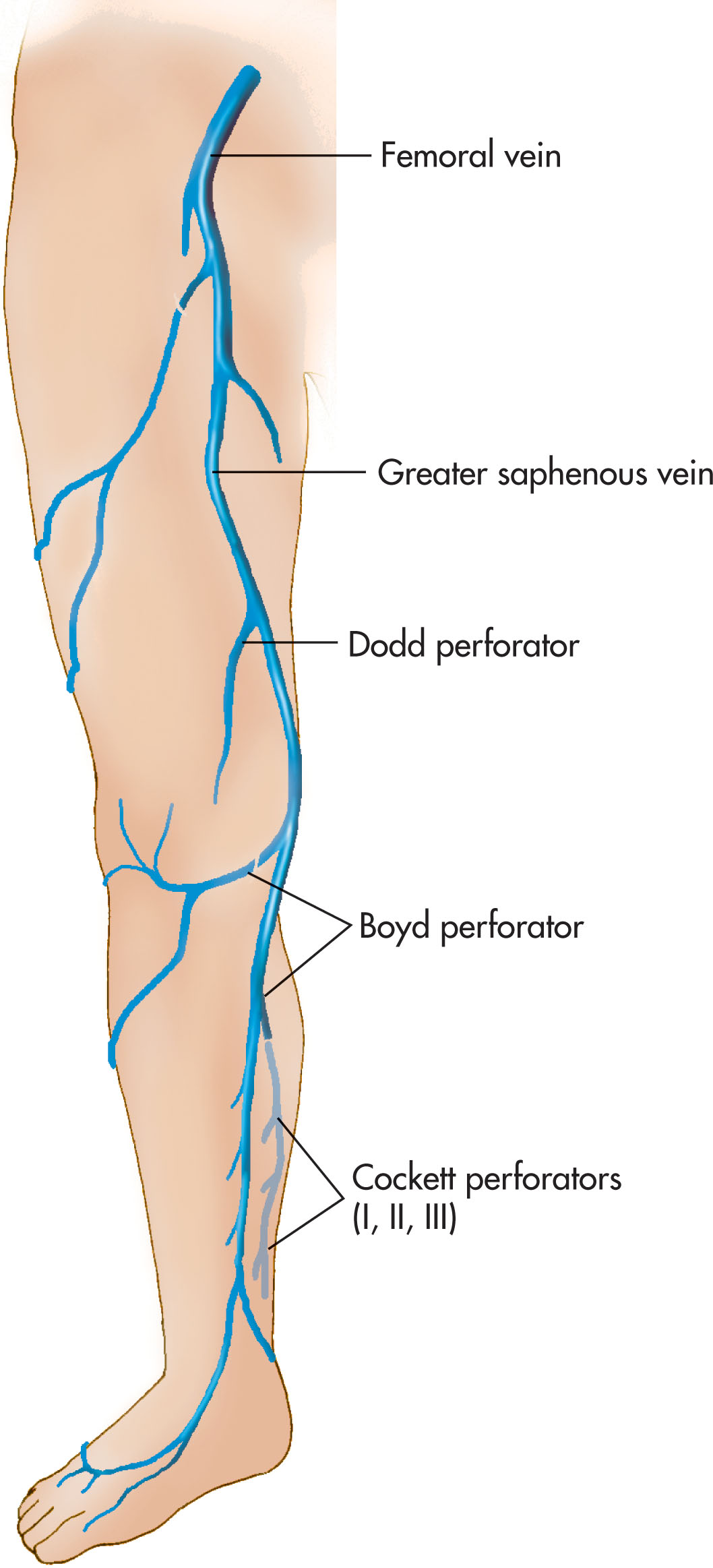
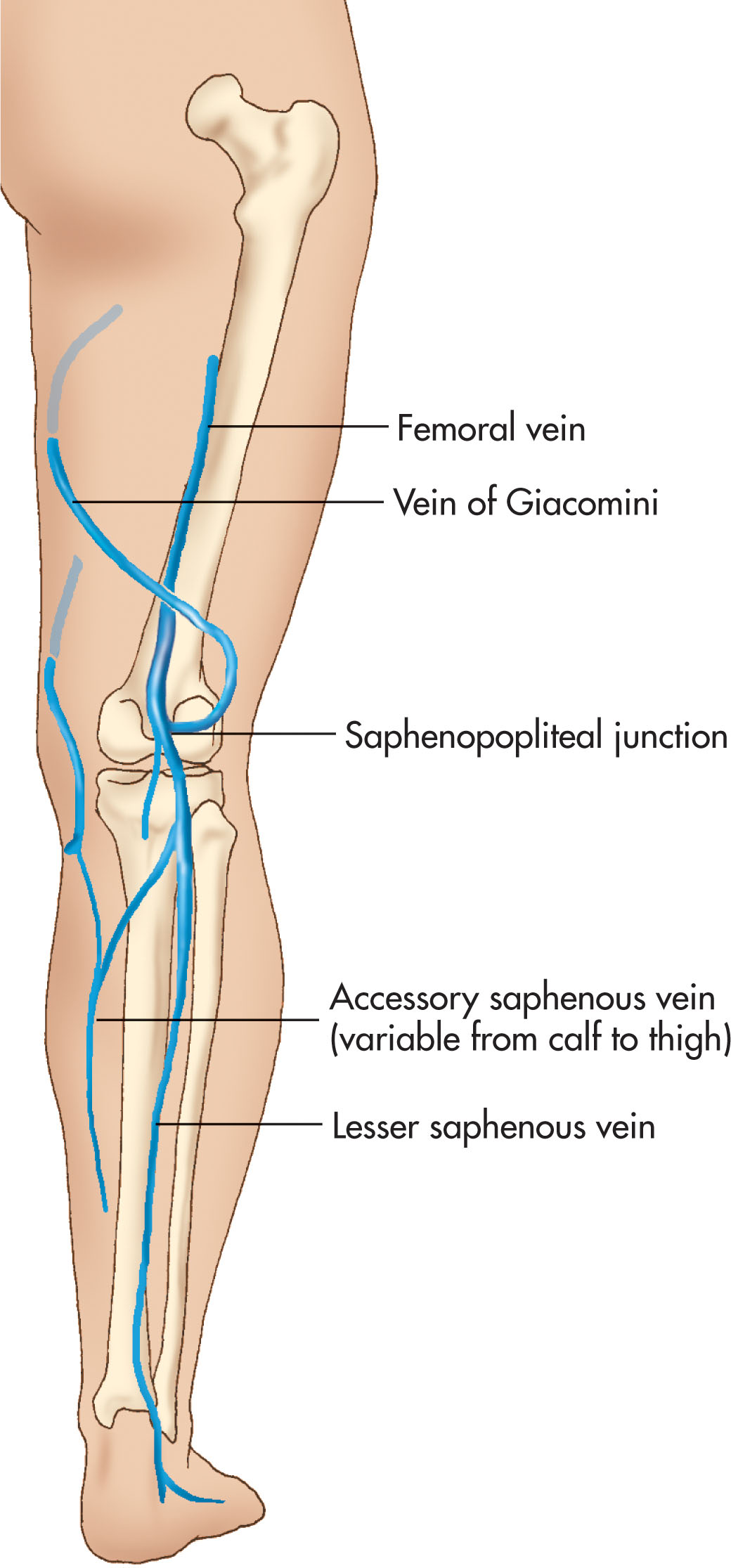
The posterior arch vein (vein of Leonardo) arises posterior to the medial malleolus and courses parallel and posterior to the GSV before it terminates into the GSV just below the knee. It also communicates with the PTV, mainly through the Cockett perforator located in the gaiter area (region above the medial malleolus) of the leg. The posterior arch vein drains blood from the medial ankle.
Perforating Veins . Perforating veins connect the superficial to the deep venous system. Perforating veins originate in the superficial fascia and penetrate the deep fascia. Like other veins, they contain one-way valves that permit unidirectional flow from superficial to deep. Many perforators exist throughout the lower extremity, with a greater number in the calf than thigh. Common perforators are Cockett, Boyd, Dodd, and Hunterian. Cockett perforators largely communicate with the posterior arch vein and are found in the lower leg. Boyd perforators are located around the level of the knee, Dodd in the distal thigh, and Hunterian in the proximal thigh.
Like the deep veins of the lower extremity, the deep veins of the upper extremity are located within the musculature of the arms, travel in close association with a corresponding artery, and serve to transport deoxygenated blood from the superficial to central venous system ( Fig. 40.4 ).
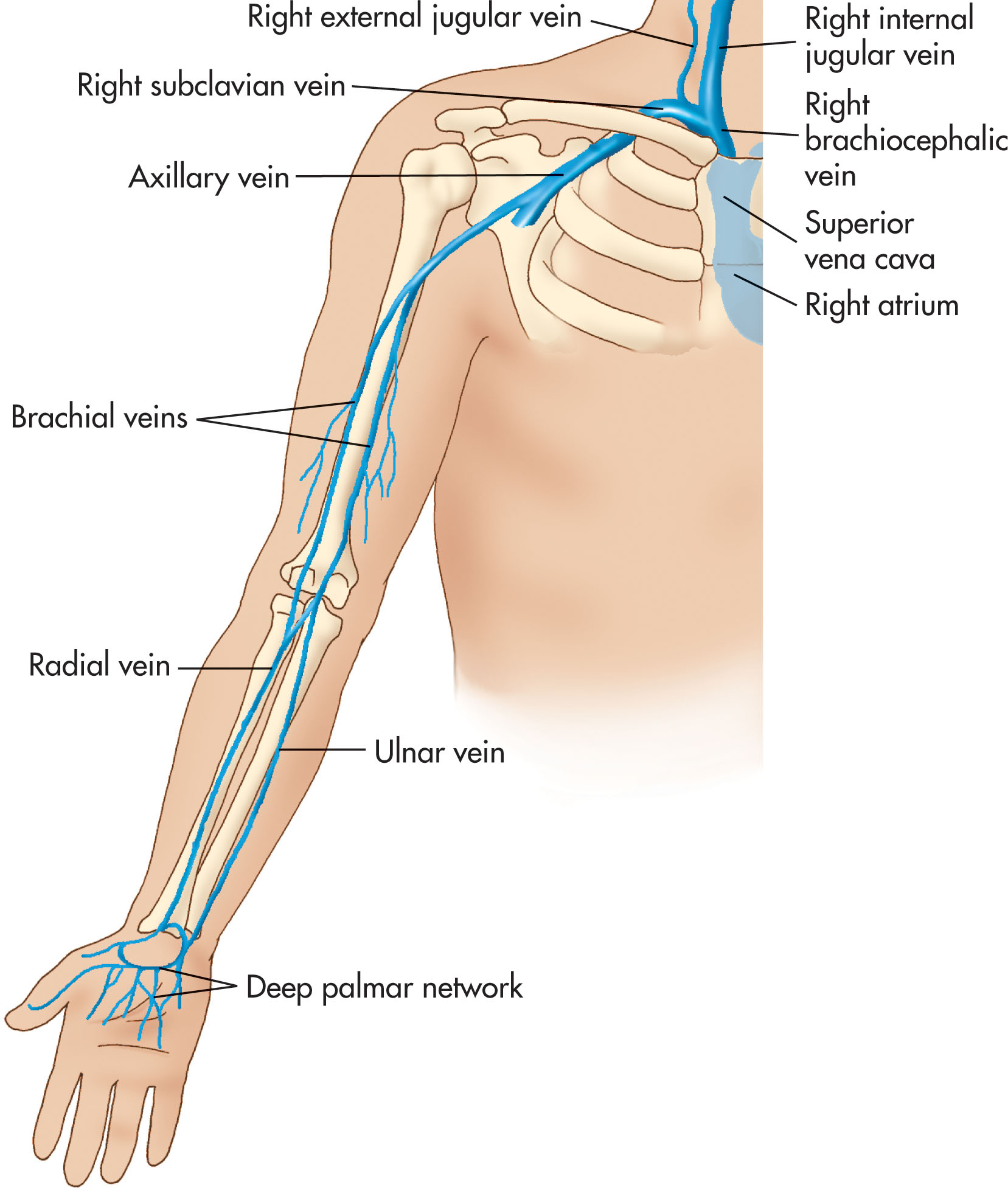
Beginning distally, the deep and superficial palmar venous arches in the hands form the paired sets of the radial and ulnar veins. This occurs on the lateral and medial sides of the arm, respectively. These veins are the primary source of venous drainage for the hand. The paired radial veins accompany the radial artery, and the paired ulnar veins accompany the ulnar artery as they ascend the forearm. Near the level of the antecubital fossa, the radial and ulnar veins join to form the brachial veins.
The brachial veins are a paired set of veins that originate from the confluence of the radial and ulnar veins near the antecubital fossa. From this location, the brachial veins ascend the upper arm on each side of the brachial artery. Just proximal to the axilla, at the inferior border of teres major, the brachial veins join the basilic vein and form the axillary vein.
The axillary vein is a single vein accompanied by the axillary artery, which originates from the confluence of the basilic and brachial veins in the upper arm. It drains blood from the upper arm supplied by the brachial, basilic, and cephalic veins, as well as the lateral portion of the thorax and the axilla. The axillary vein terminates beneath the clavicle at the outer border of the first rib, where it becomes the subclavian vein.
The subclavian vein is a continuation of the axillary vein. Accompanied by the subclavian artery, it extends from the outer border of the first rib to the inner end of the clavicle. Here it joins the internal jugular vein (IJV) to form the innominate (brachiocephalic) vein. The subclavian vein is also joined by the external jugular vein (EJV), just distal to its anastomosis with the IJV. The subclavian vein is located deep to the clavicle and is inferior and anterior to the subclavian artery.
The innominate vein (brachiocephalic vein) is formed by the confluence of the subclavian and IJVs. This is the most proximal vein of the upper extremity peripheral venous system, as the right and left innominate veins join just below the first rib to form the superior vena cava of the central venous system. Although present on both sides, the right and left innominate vary greatly. The superior vena cava terminates in the right atrium of the heart, located to the right of midline. Therefore the right innominate vein is considerably shorter than the left because it is in closer proximity to the right atrium. Furthermore, the right innominate vein courses almost vertically downward and is located superficial and to the right of the innominate artery. The right innominate vein receives the right vertebral, internal mammary, and inferior thyroid veins. As mentioned, the left innominate vein is longer than the right because it must travel across midline from the left to the right side of the chest, where it joins the right innominate vein to form the superior vena cava. The left innominate vein courses beneath the sternum at a slight downward angle and receives the left vertebral, internal mammary, inferior thyroid, and left superior intercostal veins.
The external jugular vein (EJV) drains many outer structures of the head and face. Originating in the parotid gland, the EJV courses down the neck posterior to the mandible before it crosses the sternomastoid muscle and terminates into the subclavian vein, just distal to its confluence with the IJV.
The internal jugular vein (IJV) drains the majority of the cerebral vessels and portions of the face. The IJV originates at the base of the skull in the jugular foramen and courses down the neck just lateral to the internal and then common carotid artery. At its termination, it joins with the innominate vein to form the superior vena cava.
In the upper extremity, the superficial venous system drains venous blood into the deep system for its return to the heart ( Fig. 40.5 ). The superficial veins are located between two layers of superficial fascia but outside of the deep investing fascia.
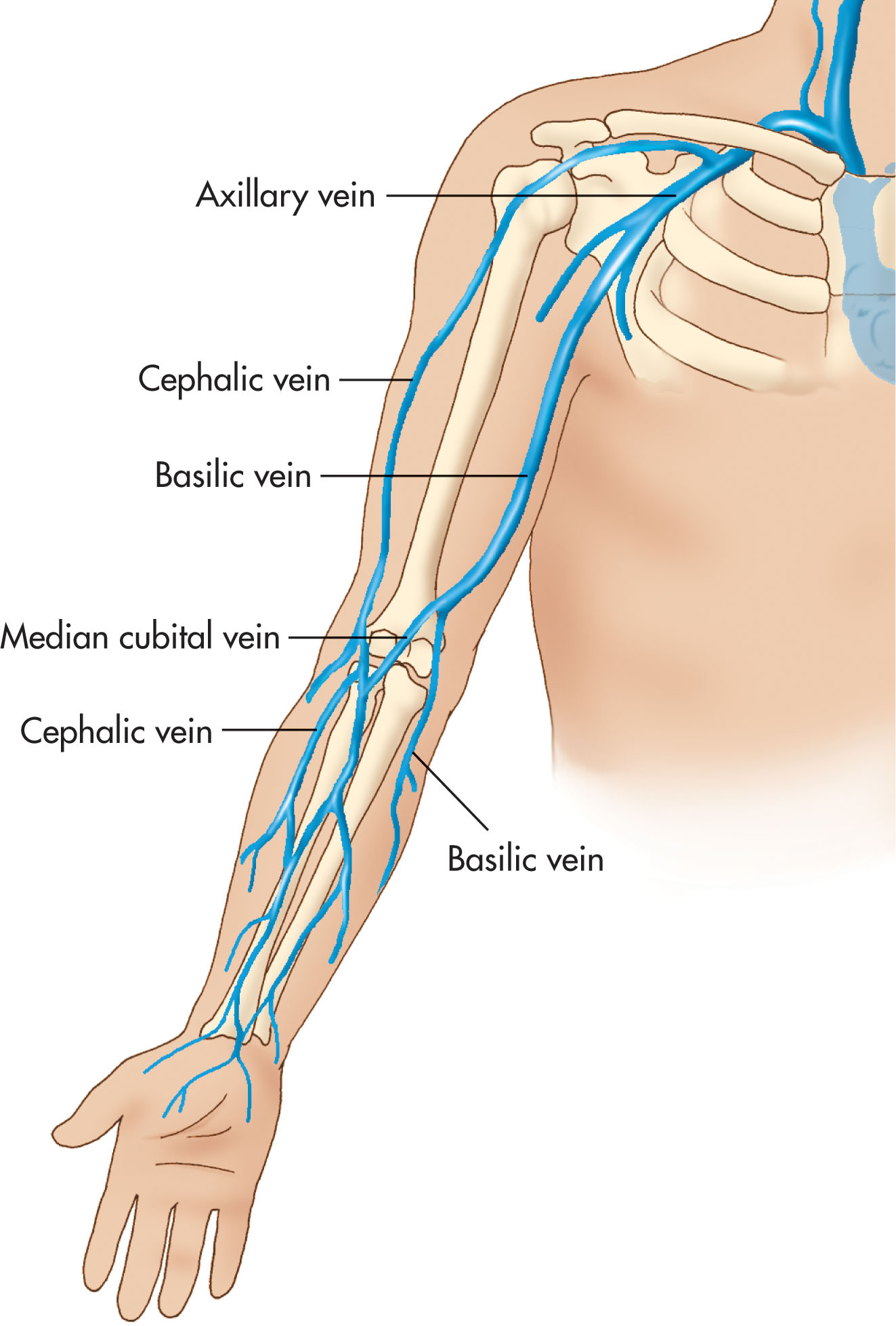
The cephalic vein begins on the lateral side of the dorsum of the hand and travels along the outer border of the biceps muscle and deltopectoral groove. The cephalic vein penetrates the deep fascia at variable levels to join the axillary vein just deep to the clavicle. The basilic vein originates on the medial side of the dorsum of the hand. The basilic vein is large and courses medially along the inner side of the biceps muscle until it pierces the deep fascia and joins the brachial veins in the upper arm.
Veins function to return deoxygenated blood to the heart once it has passed through the arterial system and capillaries (microcirculation). The arterial system is characterized as a closed, high-pressure system. Cardiac contractions apply a significant amount of kinetic energy on the arterial system, creating a pressure gradient that forces oxygenated blood through the arteries of the body and then into microcirculation, consisting of arterioles and capillaries. While in microcirculation, blood flow encounters a large amount of hemodynamic resistance due to the reduction in vessel diameter. To overcome this resistance, much of the kinetic energy supplied by the heart is exhausted. The kinetic energy of blood exiting microcirculation present within the venules is greatly reduced, with a pressure of approximately 10 mm Hg. For this reason, the venous system is characterized as a low-pressure system and why normal venous flow is nonpulsatile.
Instead of the heart, the venous system relies on the muscles surrounding the veins to propel blood forward. Contraction of the peripheral muscles mimic the heart as it relates to application of kinetic energy to the venous system. Upon contraction, the muscle will tighten and squeeze the vein within it, propelling venous blood in an antegrade direction. This is made possible by the elasticity of vein walls. In the lower extremity, this is known as the calf muscle pump, which aids in venous blood flow during ambulation. Similarly, the diaphragm contracts and descends, causing intraabdominal pressure to rise during inhalation. This pressure increase compresses a distal portion of the IVC and impedes venous outflow from the legs. With expiration, the diaphragm rises, causing intra-abdominal pressure to decrease and allowing venous flow from the legs to increase toward the IVC. For this reason, normal venous flow changes with respiration. This is called respiratory phasicity.
The other components aiding in antegrade venous flow complementing muscle contraction are the venous valves. Venous valves prevent retrograde. The shape and positioning of these valves along the lumen of the vessel are such that the force of the antegrade flow causes them to open; however, when functioning properly, retrograde flow that occurs between contractions causes the valves to close, preventing significant retrograde flow.
The venous system contains approximately two-thirds of the body’s total blood volume at any given time. Veins do not contain a fully developed tunica media (muscular layer of the lumen) as arteries do, resulting in vein walls to be more elastic, making them to appear in a variety of shapes. The cross-sectional shape of a vein is determined by transmural pressure. Transmural pressure is equal to the difference between the pressure inside the vein (intravascular) and the external pressure (interstitial pressure) placed upon the vein from surrounding tissue. Transmural pressure is also referred to as wall tension. Therefore a vein experiencing low transmural pressure will partially collapse and take on an elliptical appearance in a transverse plane, whereas a vein experiencing high transmural pressure will appear more rounded when imaged transversely. In the lower extremities, high transmural pressure is expected when standing or in a reverse Trendelenburg position, whereas a low transmural pressure is normally exhibited while in a supine position.
Deep vein thrombosis (DVT) , also known as a thrombus or blood clot, is characterized by the abnormal coagulation of red blood cells. This occurs in response to a wide variety of stimuli in which elements within the blood become altered, causing abnormal red blood cell coagulation, resulting in a thrombus. Leg thrombi frequently originate on venous valves or within the soleal sinuses of the calf. Thrombi can be isolated to a single vein or extensive (present in multiple veins). DVT can occur in the upper and/or lower extremities, but upper extremity DVTs are much less common, making up between 4% and 10% of DVT findings. DVTs can present in an acute or chronic stage and must be appropriately characterized as such because management may greatly differ between them.
Venous thromboembolism (VTE) is a condition in which a venous thrombus dislodges from the vein wall, propagates to the arteries of the lungs, and causes a pulmonary embolism (PE) . VTE is the third most common cardiovascular disorder in the United States, resulting in more than 1,220,000 cases annually. VTE also maintains a high mortality rate of approximately 19% annually.
Because of its high prevalence and life-threatening potential, venous duplex examinations are often used as a diagnostic tool for the detection of DVT. In suspected cases of thrombosis, venous duplex imaging has emerged as the imaging modality of choice, due to its superiority in accuracy over other noninvasive techniques (nonimaging Doppler, impedance plethysmography), and unlike venography has no associated risks. Symptoms commonly associated with DVT and PE are listed in Box 40.1 .
Become a Clinical Tree membership for Full access and enjoy Unlimited articles
If you are a member. Log in here